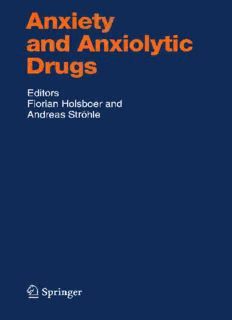Table Of ContentReprintfrom
HandbookofExperimentalPharmacology,Vol. 169
Anxiety and Anxiolytic Drugs
Editor:Florian Holsboer and Andreas Ströhle
©Springer-VerlagBerlinHeidelberg2005
PrintedinTheNetherlands.NotforSale.
ReprintonlyallowedwithpermissionfromSpringerVerlag.
123
Handbook of
Experimental Pharmacology
Volume 169
Editor-in-Chief
K.Starke,Freiburgi.Br.
EditorialBoard
G.V.R.Born,London
M.Eichelbaum,Stuttgart
D.Ganten,Berlin
F.Hofmann,München
W.Rosenthal,Berlin
G.Rubanyi,Richmond,CA
Anxiety
and Anxiolytic Drugs
Contributors
A.Bilkei-Gorzo,E.B.Binder,D.S.Charney,F.Crestani,
R.J.Daher,W.Danysz,C.H.Duman,R.S.Duman,F.Holsboer,
M.E.Keck,R.Landgraf,K.P.Lesch,R.Lieb,K.-M.Lin,
M.T.Lin,A.C.E.Linthorst,N.C.P.Low,H.Möhler,M.B.Müller,
K.R.Merikangas,J.R.Nash,A.Neumeister,D.J.Nutt,F.Ohl,
C.G.Parsons,U.Rudolph,A.Ströhle,C.W.Turck,K.Vogt,
C.T.Wotjak,R.Yehuda,W.Zieglgänsberger,A.Zimmer
Editors
Florian Holsboer and Andreas Ströhle
123
ProfessorDr.Dr.FlorianHolsboer
Max-Planck-InstitutfürPsychiatrie
Kraepelinstr.10
80804München,Germany
e-mail:[email protected]
Priv.-Doz.Dr.AndreasStröhle
KlinikfürPsychiatrieundPsychotherapie
CharitéCampusMitte
Charité–UniversitätsmedizinBerlin
Schuhmannstr.20/21
10117Berlin,Germany
e-mail:[email protected]
With139Figuresand30Tables
ISSN0171-2004
ISBN-103-540-22568-4SpringerBerlinHeidelbergNewYork
ISBN-13978-3-540-22568-3SpringerBerlinHeidelbergNewYork
LibraryofCongressControlNumber:2004115902
Thisworkissubjecttocopyright.Allrightsreserved,whetherthewholeorpartofthematerialis
concerned,specificallytherightsoftranslation,reprinting,reuseofillustrations,recitation,broad-
casting,reproductiononmicrofilmorinanyotherway,andstorageindatabanks.Duplicationof
thispublicationorpartsthereofispermittedonlyundertheprovisionsoftheGermanCopyrightLaw
ofSeptember9,1965,initscurrentversion,andpermissionforusemustalwaysbeobtainedfrom
Springer.ViolationsareliableforprosecutionundertheGermanCopyrightLaw.
SpringerisapartofSpringerScience+BusinessMedia
springeronline.com
©Springer-VerlagBerlinHeidelberg2005
PrintedinGermany
Theuseofgeneraldescriptivenames,registerednames,trademarks,etc.inthispublicationdoesnot
imply, even in theabsence of a specific statement, thatsuchnames are exempt from the relevant
protectivelawsandregulationsandthereforefreeforgeneraluse.
Productliability:Thepublisherscannotguaranteetheaccuracyofanyinformationaboutdosageand
applicationcontainedinthisbook.Ineveryindividualcasetheusermustchecksuchinformationby
consultingtherelevantliterature.
Editor:Dr.P.Roos
DeskEditor:S.Dathe
Coverdesign:design&productionGmbH,Heidelberg,Germany
Typesettingandproduction:LE-TEXJelonek,Schmidt&VöcklerGbR,Leipzig,Germany
Printedonacid-freepaper 27/3151-YL-543210
Preface
Researchonanxietyandanxietydisordersisundergoingaparadigmatictrans-
formationasdisparateareasofpsychiatricnosology,epidemiology,pharma-
cologyandcognitiveneuroscienceconvergetowardsanintegratedunderstand-
ingofthepathophysiologyofthesedisorders.
Inthelastcentury,thebasictreatmentindicatedforpatientswithanxiety
disorderswastoemploypsychotherapytofacilitatechangesinbehaviourand
developwaysofcopingwithstressfullifeevents.Awidespectrumofsomatic
treatments from catharsis and emetics to opium and strengthening tonics,
from atropine and digitalis to potassium bromide and chloral hydrate, from
benzodiazepinestoantidepressantscametobeusedaswell.Systematicstudies
of antidepressants revealed that these drugs have antipanic properties inde-
pendentoftheirantidepressiveeffects.Thisfindingstirredanewclassification
of anxiety disorders, which is reflected in the current classification systems,
suchastheinternationalclassificationofdiseases(ICD)publishedbytheWorld
HealthOrganization(WHO).Anxietyhasevolvedasadefensivemechanism
disposing the individual to recognize changes. As a warning signal, anxiety
haslife-savingqualities,andaspecieswithoutappropriateanxietywouldnot
survive. While normal anxiety is beneficial to co-ordinate response patterns
inathreateningsituation,pathologicalanxietyhasmanyfacetsthatcanbur-
den an individual substantially and warrants therapeutic intervention. The
newclassificationofanxietydisordersencouragedbasicandclinicalresearch
on the pathophysiology and treatment of pathological anxiety. Using newly
developedmethodsandtechniques,wearenowbeginningtounderstandthe
molecular mechanisms of anxiety, anxiety disorders and their treatment. In
parallel, new drug targets have been generated and the first clinical studies
withnewcompoundshavebeenstarted.
Inthefirstchapter,C.T.Wotjakdescribestheresultsofstudiesonthecellular
basisoflearningandmemorytogetherwithadescriptionofthemethodsthat
ledtothesediscoveries.Aversivelymotivatedlearningandmemoryenableus
torecognizeandtoappropriatelyrespondtopotentiallydangeroussituations.
Theseabilities,whichensuredthesurvivalofhumansandanimalsthroughout
evolution,beartheriskofpathologicalalterationthatmightbedirectlylinked
todistincthumananxietydisorders,suchasphobiasorpost-traumaticstress
disorder.
VI Preface
Adetailedoverviewofanimalmodelsforanxiety-relatedbehaviourispre-
sentedbyF.Ohl.Thesemodelsareindispensabletoolstounraveltheneuro-
biologicalmechanismsunderlyingnormalanxietyaswellasitspathological
variations.Themainconceptsingeneratinganimalsmodelsforanxiety,i.e.se-
lectivebreeding,experience-relatedmodels,geneticallyengineeredmice,and
phenotype-drivenapproaches,aredescribedandthepotentialopportunities
andcaveatsofcurrentmodelsaswellastheemergingpossibilitiesofferedby
genetechnologyarediscussed.
Although current views emphasize the joint influence of genes and envi-
ronmental sources during early brain development, the physiological com-
plexities of multiplegene and environment interactions as well as cross-talk
betweenminor gene variants inthedevelopmentalneurobiologyof fearand
anxietyremainpoorlyunderstood.Focusingonthehypothalamic–pituitary–
adrenocorticalsystem,substancePandtheserotonergicsystem,threechapters
describetheimpactofmutagenesisandknockouttechniquesonourcurrent
understandingofanxiety-relatedbehaviour.K.P.Leschreviewsfindingsshow-
ingthatvariationsingenescodingforproteinsthatcontrolserotonin(5-HT)
systemdevelopmentandplasticityestablish5-HTneuronidentityandmodu-
late5-HTreceptor-mediatedsignaltransduction,andcellularpathwayshave
beenimplicatedinthegeneticsofanxietyandrelateddisorders.Inparticular,
pertinentapproachesregardingphenotypicchangesinmicebearinginactiva-
tionmutationsof5-HTreceptors,5-HTtransporter,monoamineoxidaseAand
othergenesrelatedto5-HTsignallingarediscussed.M.E.KeckandM.B.Müller
describe how neuroendocrine and behavioural phenotypes of anxiety disor-
ders are at least in part mediated via modulation of corticotropin-releasing-
hormone (CRH) and vasopressin (AVP) neurocircuitry and that normaliza-
tionofanalteredneurotransmissionaftertreatmentmayleadtorestorationof
disease-relatedalterations.A.Bilkei-GorzoandA.Zimmershowthatanxiety
anddepression-relatedphenotypesareprofoundlyaffectedbythetachykinin
system.
ThegeneticepidemiologyofanxietydisordersisreviewedbyK.R.Merikan-
gas and N.C.P. Low. They conclude that better comprehension of the phe-
nomenologyofthespecificanxietydisordersandtheiroverlapshouldguide
the development of the next phase of diagnostic categories. In light of the
rapidlyaccumulatinginformationongeneticvariationsassociatedwithanx-
ietydisorders,wecanexpectthatbasedonthesegeneticdatanewdrugswill
emerge not only for better treatment of the clinical conditions but also for
preventingtheironset.
The interactions betweenCRH and 5-HT and the implicationsfor theae-
tiology and treatment of anxiety disorders are reviewed by A.C.E. Linthorst.
A. Neumeister, R.J. Daher and D.S. Charney focus on the central role of no-
radrenergic neurotransmission for fear, anxiety and consequently the devel-
opment and treatment of anxiety disorders. H. Möhler, K. Vogt, F. Crestani
γ
and U. Rudolph review the pathophysiology and pharmacology of the -
Preface VII
aminobutyricacid(GABA) receptors.ThediversityoftheGABA receptors
A A
as described in the past decade is the basis for novel subtype selective ben-
zodiazepinesiteligandswithhypnotic,anxiolytic,anticonvulsiveormemory-
enhancingactivity.
Thephysiologyandpathologyofexcitatoryaminoacidneurotransmission
isdescribedbyC.G.Parsons,W.DanyszandW.Zieglgänsberger.Atpresent,
thereseemstobeaconsensusthatcompetitiveAMPAandN-methyl-d-aspar-
tate (NMDA) receptor antagonists have a low chance of finding therapeutic
applications. Antagonists showing moderate affinity and satisfactory selec-
tivity for certain NMDA receptor subtypes seem to have a more favourable
profile.
C.H. and R.S. Duman focus on signal transduction and neural plasticity
in the neurobiology and therapy of anxiety. The challenge of identifying in-
tracellularsignallingpathwaysandrelatedmolecularandstructuralchanges
thatarecriticaltotheaetiologyandtreatmentofanxietydisorderswillfurther
confirm the importance of mechanisms of neuronal plasticity in functional
outcomeandimprovetreatmentstrategies.
Anxiety modulation by neuropeptides is described by R. Landgraf. Par-
ticularly due to their high number and diversity, the dynamics of their cen-
tral release and the multiple and variable modes of interneuronal commu-
nication they are involved in, neuropeptides play a major role in the reg-
ulation of anxiety-related behaviour. Despite the immense progress in the
field of neuropeptides and anxiety, we are far from mimicking these pro-
cesses simply by administering synthetic agonists or selectively attenuating
thepathology byadministrationof receptorantagonists.The onlyexception
seemsthedevelopmentofantagonistsblockingtheeffectsofCRH.Oneofthe
CRH receptor antagonists has been probed in a clinical study with promis-
ing results. From the clinical perspective, R. Yehuda describes the neuroen-
docrine aspects of post-traumatic stress disorder (PTSD). The observations
in PTSD are part of a growing body of neuroendocrine data providing ev-
idence of insufficient glucocorticoid signalling in stress-related psychiatric
disorders.
Theclinicalpresentationofanxietydisordersaccordingtothefourthedition
of the Diagnostic and Statistical Manual of Mental Disorders is summarized
by R. Lieb. In addition, selected aspects (prevalence, correlates, risk factors
andcomorbidity)ofepidemiologicalknowledgeonanxietydisordersarepre-
sented.
Pharmacogenetics is a field of research increasing our knowledge on the
use of psychotropic drugs in different ethnic patient populations. K.-M. and
M.T.Lin’schapterontransculturalissuessummarizescurrentknowledgeon
themetabolismofanxiolyticagentswithemphasisonpharmacogeneticsand
ethnicvariationsindrugresponses.
Challenge studies in anxiety disorders are highlighted by M.E. Keck and
A. Ströhle. The heterogeneity of agents capable of producing panic attacks
VIII Preface
insusceptiblepatientsandtheinconsistencyofautonomicresponsesduring
apanicattackhasledtotheassumptionthatpanicoriginatesinanabnormally
sensitivefearnetwork,whichincludestheprefrontalcortex,insula,thalamus,
amygdalaandamygdalarprojectionstothebrainstemandhypothalamus.The
differences in sensitivity to certain panicogens, therefore, might be fruitful
in serving as biological markers of subtypes of panic disorders and should
be a major focus of research, as the identification of reliable endopheno-
types is currently one of the major rate-limiting steps in psychiatric genetic
studies.
Thecurrentstateonthepharmacotherapyofanxietydisordersissumma-
rizedbyJ.R.NashandD.J.Nutt.Therecentshiftinclinicalpracticetowardsthe
useofantidepressants,particularlySSRIs,forthefirst-linetreatmentofanxi-
etydisordersissupportedbyresearchevidencefromrandomizedcontrolled
trials. It is only in recent years that drugs acting via GABA neurotransmis-
sionhavebeensupplantedasfirst-linetreatments,andnewdrugsinthisclass
with improved tolerability compared to the benzodiazepines are likely to be
marketedinthenearfuture.
Newdevelopmentsinthepharmacologicaltreatmentofanxietydisorders
aresummarizedbyA.Ströhle.Furthercharacterizationofpathophysiological
processesincludingevolvingtechniquesofgenomicsandproteomicswillgen-
eratenewdrugtargets.Drugdevelopmentdesignwillgeneratenewpharma-
cologicalsubstanceswithspecificactionatspecificneurotransmitterandneu-
ropeptidereceptorsortheirreuptakeandmetabolism.Newanxiolyticdrugs
maytargetreceptorsystemswhichonlyrecentlyhavebeenlinkedtoanxiety-
relatedbehaviour.Combiningpsychopharmacologicalandpsychotherapeuti-
calinterventionsisafurtherfieldwherebenefitsforthetreatmentofanxiety
disorderscouldbeachieved.Althoughtheroadofdrugdevelopmentisardu-
ous,improvementsinthepharmacologicaltreatmentofanxietydisordersare
expectedforthenearfuture.
PharmacogeneticstrategiesinanxietydisordersaredescribedbyE.B.Binder
and F. Holsboer. This field holds great promise for the treatment of anxiety
disorders, and in the future psychiatrists may be able to base the decision
regardingthetypeanddoseofadescribeddrugonmoreobjectiveparameters
thanonlythediagnosticattributionsusedsofar.Thiswilllimitadversedrug
reactionsandcouldreducetimetoresponse,resultinginamoreindividualized
pharmacotherapy.
Introducingproteomics,C.W.Turckshowsthatthecomprehensiveanalysis
of the protein complement of the genome of an organism is becoming an
increasinglyimportantdisciplinefortheidentificationofdiseasetargets.The
effectsofdrugtreatmentandmetabolismcannowbestudiedontheprotein
levelinacomprehensivemanner.
Wethank allthecontributingauthorsfor theirexcellentmanuscripts. We
thankK.Starke,whohasinitiatedthisvolumeandtheSpringer-Verlagteam,
especially S. Dathe, for the smooth co-operation. With this volume of the
Preface IX
HandbookofExperimentalPharmacology,wearehappytopresentanoverview
onthecurrentstateofbasicandclinicalresearchon“AnxietyandAnxiolytic
Drugs”.
MunichandBerlin,March2005 F.Holsboer,A.Ströhle
Description:The present volume gives a comprehensive overview on the current state of basic and clinical research on Anxiety and Anxiolytic Drugs. Using newly developed methods and techniques researchers are now beginning to understand the molecular mechanisms of anxiety, anxiety disorders and their treatment.

